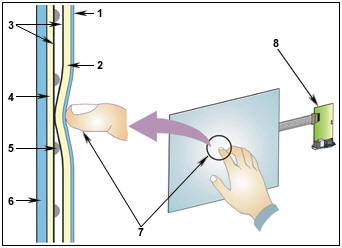


By Wayne Maruna
Weíve been using touch screens for so long now, I canít even recall the first time I used one. It may have been on an old HP PDA (personal digital assistant) which used a stylus, or it may have been when I first signed my name on a credit card processing device and my signature looked like it had been written by a four-year-old. That actually hasnít changed a whole lot in the interim, but touch screens have become ubiquitous with the popularity of cell phones, tablets, e-readers, and to a much lesser extent computer and laptop screens. We use them every day, but how many of us know how touch screens work? We know we touch a spot or we Ďswipeí our finger, and magic happens. Follow along as I try to provide a brief explanation without getting into too much technical jargon, although if youíre willing to just accept Ďmagicí, you can stop here and move on.
Iíve read that there are as many as eighteen types of touch screen technologies, but for the most part there are two that are used most extensively: resistive and capacitive. Fear not, Iím not a physicist or an electrical engineer, so Iím not going to talk about atoms and ions, but there are a few terms which must be employed to understand how these screens work.
Resistive Touch Screens

Letís start with resistive touch screens. These are used in places like ATMs and the supermarket checkout. This is a mechanical approach that involves a moving part. Think of the screen as being covered with two electrically charged layers separated by an air gap sustained by teeny tiny spacers. When you press the top layer hard enough, you might feel it bend in slightly. Thatís the moving part. The upper charged layer then makes contact with the lower charged layer, causing a change in the current flowing through the two layers. Devices determine the coordinates of where the touch took place, and software then knows what was intended and reacts accordingly. Resistive touch screens are durable and relatively inexpensive to make. They work regardless of whether the touch was made by a finger, a stylus, or the tip of your nose. But they can only sense one touch at a time, hence no two-finger gestures that we see on modern cell phones. Resistive touch screens can also be harder to read because the multiple layers reflect more ambient light. Thatís why the screens at the gas pumps and ATMs can be difficult to read in sunlight Ė and it seems like the sun is always shining directly at them regardless of orientation or time of day.
[Image Credit: Chassis Plans via ScienceOnline.org]
Capacitive Touch Screens

This type of touch screen is also constructed of two layers of conductive materials, usually a thin transparent film of indium tin oxide, separated by an insulating material like a thin sheet of glass. The conductive layers store electrical charges in an electrostatic grid of tiny wires thinner than human hair. When you touch the screen with your finger, it steals a little of the charge from each conductive layer at the point of touch. The charge is tiny so you donít feel any shock, but it is sufficient to create a slight voltage drop that sensors can locate, measure, and send to a computer chip to carry out the intended action. This works because we humans are electrical conductors. Try doing this with gloves, and youíll find the touch screen does not work Ė not unless you are wearing special gloves made with conductive thread. That is also why using just your fingernail does not work Ė itís a lousy conductor that wonít steal enough of a charge to make a measurable difference.
[Image credit: Electrotest via ScienceOnline.org]
This got me to wondering what happens to all those electrical charges I have been Ďstealingí with my finger. The theory I have evolved is that my body has become a capacitor storing this electrical energy until such time as I approach a green traffic signal. Somehow, the stored electricity is converted to radio waves that are picked up by circuitry in the traffic light which triggers an immediate switching to first yellow and then quickly to red.
This happens far too often for it to be due to mere random probability.

Reference sources: HowStuffWorks.com, scienceonline.org, explainthatstuff.com, Computerworld.com (10/17/12)